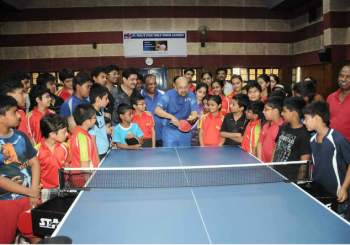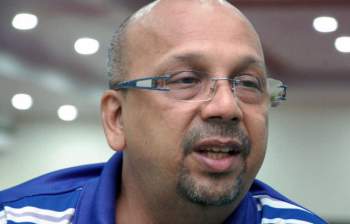TABLE TENNIS / INTERVIEW / KAMLESH MEHTA
“Although corporate sponsorship is lacking, the scene in table tennis is getting better. One needs to learn from cricket marketing and adapt on a smaller scale, although finding sponsors for TT would be tougher,” says Kamlesh Mehta in this interview to A. Joseph Antony.
Eight-time national champion Kamlesh Mehta was in Rajahmundry at the invitation of the Andhra Pradesh Table Tennis Association (APTTA) to conduct a camp for the state’s players. On his way back to Mumbai, he had a brief stop-over at the St. Paul’s Table Tennis Academy in Hyderabad. The elder statesman of Indian table tennis spoke to Sportstar on the game in India and the world over. Excerpts:
Question: Have you played in any of the foreign leagues/clubs?
Answer: I had offers to play in Germany and Italy in 1987, 88 but they didn’t materalise.
Where does table tennis thrive across the world ?
The league is strongest in Germany. Sweden, Italy, Spain, France and China (highly restricted to domestic players except for a few top rung internationals) also have flourishing systems. It’s doing well in Bangladesh too. Earlier, Indian players were invited but now they are inviting Asian level paddlers as well.
Who funds them?
Local affiliation plays a strong role, area community centres providing the platform. For instance, the sport in Falkenberg, Sweden is supported by local hotels, resorts and businesses. Banners at venues give sponsors mileage.
Often it’s less of T shirt and more sponsor logos on players! Clubs are also affiliated to TT equipment manufacturers, who provide not only tables and balls but also racquet rubbers to players, representing the club.
A home and away system means fairly decent ticket sales. While some clubs have small sponsors, the bigger ones are backed by corporates and MNCs. Club membership is another source of revenue besides renting out the venue for social functions, musical evenings and so on.
Whom do they entertain?
Mainly locals attend tournaments besides visiting fans, although they are nowhere as numerous as the followers of football.
How do they sustain themselves?
Clubs plan their budgets well, so much so that their closure is very rare. With a restriction on foreign players, a club’s financial well-being decides how many big guns they can hire.
Who invests in these clubs?
Besides sponsors looking for mileage for their patronage, there are owners also. People do put their money into table tennis.
Is it possible to have an IPTTL on the lines of the successful Indian Volley League (IVL)? If not, why?
If badminton, a non-cricket sport, has succeeded with leagues in Maharashtra and Karnataka, I don’t see why not table tennis too. As early as the 60s itself, there were inter-office and inter club leagues in Mumbai.
There was no money, since clubs were more social in approach than sports oriented. Nonetheless, they offered opportunities to players to not only get noticed but get recruited by various companies.
Nowadays, club membership fees have skyrocketed, denying the average citizen a chance. The social aspects have taken precedence over sports in most clubs. Recruitment of paddlers has reduced drastically too.
How can sponsors be roped in?
Although corporate sponsorship is lacking, the scene in table tennis is getting better. One needs to learn from cricket marketing and adapt on a smaller scale, although finding sponsors for TT would be tougher.
How can the support base be widened?
Good coaches would make a big difference as they help spread knowledge of the sport. Right now, coaching’s not an attractive career. In my time, coaching was almost non-existent. In China there’s no dearth of good coaches.
Why don’t schools take up TT in a bigger way?
Sports in schools is vanishing steadily with urban areas offering little space and rural areas no facilities. TT’s distinctive advantages are initial investment and space requirement are low.
It can also be played on a dining table by one belonging to any age group. So there’s huge scope to popularise the game. Sadly, the stars in TT are few, compared to say badminton.
Media coverage of local sports events has reduced drastically, in some cases finding place only a couple of times a week. Instead newspapers have European and international football. So without media attention, player interest also dwindles.
What is needed to promote the game?
Only money is not the answer. Events should be organised well. Marketing can be better. The system should throw up more stars. Increased media participation and support should be encouraged. With some good leadership and administration, the game can grow.
After a flamboyant start, why did the ONGC TT league in Kolkata fail to take off?
 Kamlesh Mehta during his coaching stint in Hyderabad / Photo:AHMED MOHIUDDIN SALEEM
Kamlesh Mehta during his coaching stint in Hyderabad / Photo:AHMED MOHIUDDIN SALEEM
I have heard various reasons but don’t know myself, but I wish it had taken off.
What prevents clubs in India from supporting the game?
Club culture supportive to table tennis is lacking in the country, except in Bengal perhaps. Sports facilities are limited to members only, unlike foreign countries, where they are open to the community.
Do you have a role in TTFI?
Along with Bhawani Mukherjee, Montu Ghosh, Manjit Dua and Monalisa Mehta, I’m on the TTFI panel of national selectors.
What do you do outside TT?
I coach at the Matunga Gymkhana in Mumbai, besides administrative involvement in the conduct of TT here. I’m also a brand ambassador for Stag International and will shortly from now monitor progress of players they are sponsoring.
Like I came to AP, I hold camps in various States. I am going to Gujarat soon. I am involved in the development and promotion of TT.
Are your children into the game?
Our son Sunit Mehta played state level upto class XII, representing Mumbai in sub-junior, junior and youth championships.
Do you have a vision for the game in the country?
In our time, India had reached a ranking of No. 12 in the world. Now I hope we crack the top 10.
source: http://www.SportStarnet.com / Vol. 35, No. 20, May 17th, 2012
